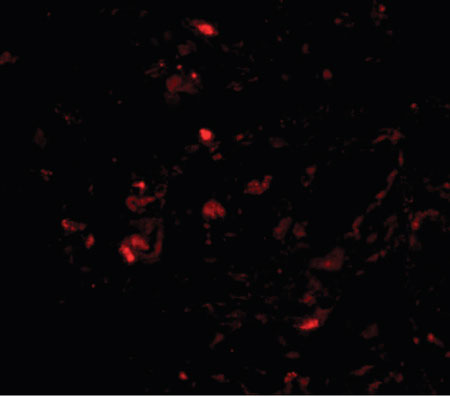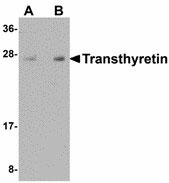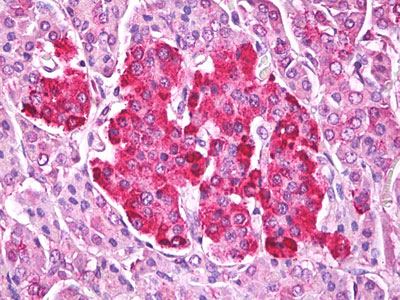TTR / Transthyretin Antibody (Internal)
Chicken Polyclonal Antibody
- SPECIFICATION
- CITATIONS
- PROTOCOLS
- BACKGROUND

Application
| WB, IHC-P, IF, E |
|---|---|
| Primary Accession | P02766 |
| Reactivity | Human, Mouse, Rat |
| Host | Chicken |
| Clonality | Polyclonal |
| Calculated MW | 16kDa |
| Dilution | IHC-P (5 µg/ml), WB (1-2 µg/ml), |
| Gene ID | 7276 |
|---|---|
| Other Names | Transthyretin, ATTR, Prealbumin, TBPA, TTR, PALB |
| Target/Specificity | Human TTR |
| Reconstitution & Storage | Short term 4°C, long term aliquot and store at -20°C, avoid freeze thaw cycles. Store undiluted. |
| Precautions | TTR / Transthyretin Antibody (Internal) is for research use only and not for use in diagnostic or therapeutic procedures. |
| Name | TTR |
|---|---|
| Synonyms | PALB |
| Function | Thyroid hormone-binding protein. Probably transports thyroxine from the bloodstream to the brain. |
| Cellular Location | Secreted. Cytoplasm. |
| Tissue Location | Detected in serum and cerebrospinal fluid (at protein level). Highly expressed in choroid plexus epithelial cells Detected in retina pigment epithelium and liver |

Thousands of laboratories across the world have published research that depended on the performance of antibodies from Abcepta to advance their research. Check out links to articles that cite our products in major peer-reviewed journals, organized by research category.
info@abcepta.com, and receive a free "I Love Antibodies" mug.
Provided below are standard protocols that you may find useful for product applications.
Background
Thyroid hormone-binding protein. Probably transports thyroxine from the bloodstream to the brain.
References
Mita S.,et al.Biochem. Biophys. Res. Commun. 124:558-564(1984).
Wallace M.R.,et al.Biochem. Biophys. Res. Commun. 129:753-758(1985).
Sasaki H.,et al.Gene 37:191-197(1985).
Tsuzuki T.,et al.J. Biol. Chem. 260:12224-12227(1985).
Mita S.,et al.J. Biochem. 100:1215-1222(1986).
If you have used an Abcepta product and would like to share how it has performed, please click on the "Submit Review" button and provide the requested information. Our staff will examine and post your review and contact you if needed.
If you have any additional inquiries please email technical services at tech@abcepta.com.













 Foundational characteristics of cancer include proliferation, angiogenesis, migration, evasion of apoptosis, and cellular immortality. Find key markers for these cellular processes and antibodies to detect them.
Foundational characteristics of cancer include proliferation, angiogenesis, migration, evasion of apoptosis, and cellular immortality. Find key markers for these cellular processes and antibodies to detect them. The SUMOplot™ Analysis Program predicts and scores sumoylation sites in your protein. SUMOylation is a post-translational modification involved in various cellular processes, such as nuclear-cytosolic transport, transcriptional regulation, apoptosis, protein stability, response to stress, and progression through the cell cycle.
The SUMOplot™ Analysis Program predicts and scores sumoylation sites in your protein. SUMOylation is a post-translational modification involved in various cellular processes, such as nuclear-cytosolic transport, transcriptional regulation, apoptosis, protein stability, response to stress, and progression through the cell cycle. The Autophagy Receptor Motif Plotter predicts and scores autophagy receptor binding sites in your protein. Identifying proteins connected to this pathway is critical to understanding the role of autophagy in physiological as well as pathological processes such as development, differentiation, neurodegenerative diseases, stress, infection, and cancer.
The Autophagy Receptor Motif Plotter predicts and scores autophagy receptor binding sites in your protein. Identifying proteins connected to this pathway is critical to understanding the role of autophagy in physiological as well as pathological processes such as development, differentiation, neurodegenerative diseases, stress, infection, and cancer.




